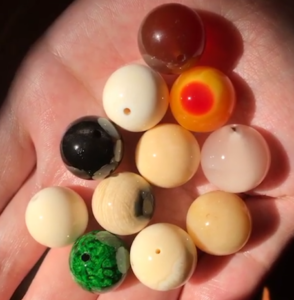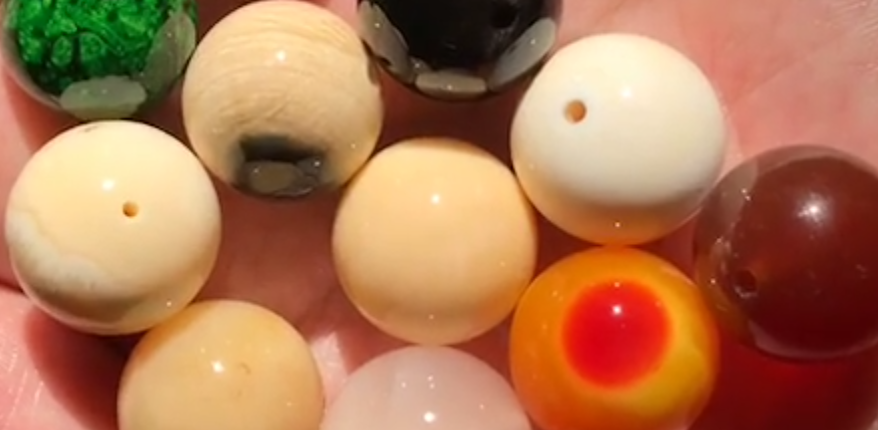Wenwan: The Chinese subculture underlying trade and collection of wildlife parts and products
By: Jack Y.K. Lam, Doctoral Researcher, City University of Hong Kong
Artworks, collectables, carvings, decorations, ornaments, jewelleries, trinkets are all terms which refer to a variety of end-uses and products, yet when it comes to the illegal wildlife trade (IWT) they are often used indiscriminately to describe commodities or products that many wildlife parts become. Consider the range of elephant ivory products shown in figure 1 – each could fall under a combination of the aforementioned terms, but these terms also fail to capture the diversity of products observed. The language currently used in the wildlife conservation literature misrepresents the depth of the consumer demand and market, and struggles to present the issue in its entirety. Thus, it is a serious blind spot in comprehending the trade.

Figure 1. Elephant ivory can become many Wenwan products. Clockwise from top left: prayer beads, figurines, rings, bangles, mahjong tiles, chopsticks, teapot, and comb. Photo credit: Jack Y.K. Lam
There is, in fact, a central theme: Wenwan, that pulls together the different products. It provides a much-needed cultural context to the demand, and a cohesive narrative from a consumer perspective to explain the connections between the different products and species traded.
The Chinese phrase, Wenwan (文玩) translates literally to “toys of culture/sophistication”. It is as much of a hobby of collection as it is a subculture. Wenwan epitomises an abstract cultural ideal of being educated, tasteful, and sophisticated, all of which alludes to wealth and success. It is through the collection and appreciation of these “toys” that Wenwan followers showcase these qualities.
Apart from being a symbol of social and economic status, much of the appeal of Wenwan comes from its speculation value and investment potential, with many traders and followers hoping to turn a quick profit in its trade. Key to the collection value of Wenwan is the material that items are made of. Of all the raw materials of Wenwan, wildlife parts represent only a sub-type of “organic gemstones”, yet it is within this small group that some of the most highly valued varieties for Wenwan exist. The valuation of Wenwan items is complex and can be arbitrary given its inherent artistic attributes, but since much of the items’ worth is tied to the material they are made of, the rarity of the species generally translates to higher prices. While some endangered species such as elephants and rhinos are well-known examples of the Wenwan trade, the list of victims extends far beyond the commonly highlighted species (figure 2).

Figure 2. “My zoo collection” is the caption of one Wenwan trader’s social media post from early 2018. Beads shown here are made of ivory (African elephant, hippo, mammoth, walrus, sperm whale, narwhal), bone (tiger), casque (helmeted hornbill), horn (rhino, saiga), and skin (Asian elephant). Photo credit: Jack Y.K. Lam
Understanding Wenwan is pivotal to wildlife conservation because it aligns and contextualises existing information in the field. It anchors our current knowledge of different products and species traded and clarifies their connections. An example is the phrase: “black, red, white” which is commonly used among Wenwan followers to rank rhino horn, helmeted hornbill casque, and elephant ivory as the top three raw materials. Identifying such product grouping and ranking helps to prevent poorly targeted campaigns for just one species or product, which can potentially displace demand to another. In recent years, the Wenwan trade has experienced cross-over of a number of wildlife parts used in traditional medicine trade. This has been the case for products such as saiga antelope horn (ling yang, 羚羊), pangolin scales, and most recently elephant skin for which market values have drastically increased as a result.
Recognising such inherent flexibility and fluidity of the Wenwan market, and its receptive nature to different products and species, helps researchers identify emerging threats and appropriate counter actions. The concept of Wenwan provides a map to navigate what is an integral, but convoluted, part of IWT. It brings to the surface tangled relationships between wildlife products, commodities, their trade routes, and associated illegal trade networks. It helps researchers ground and connect respective focuses in relation to another, to identify opportunity for collaboration, and devise effective campaigns to target multiple trade chains whilst accounting for the risk of demand displacement. For many illegally traded products, Wenwan is the framework IWT researchers should apply to understand and unify findings, thereby maximising the effectiveness of efforts to tackle IWT.
Article edited by: Nafeesa Esmail





 Neil C. D'Cruze
Neil C. D'Cruze Florian Büttner
Florian Büttner